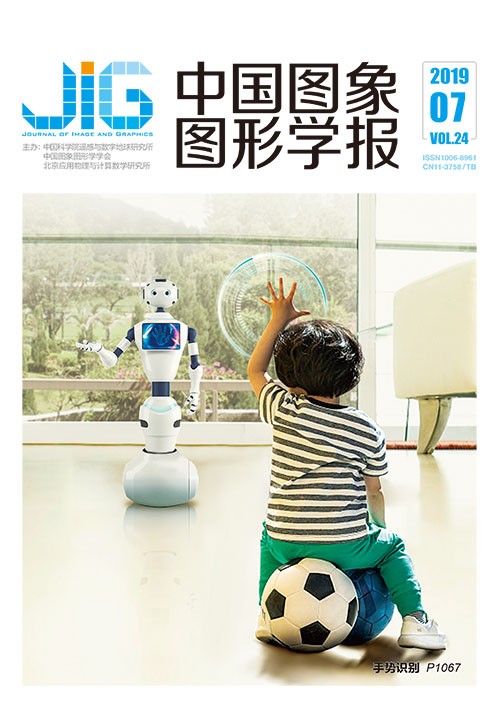
结合颜色属性的分层结构直方图
摘 要
目的 为克服单一颜色特征易受光照变化影响,以及图像的空间结构特征对目标形变较为敏感等问题,提出一种结合颜色属性的分层结构直方图。方法 首先,鉴于使用像素灰度值对图像进行分层易受光照变化影响,本文基于颜色属性对图像进行分层,即将输入的彩色图像从RGB空间映射到颜色属性空间,得到11种概率分层图;之后,将图像中的每一个像素仅投影到其概率值最大的分层中,使得各分层之间像素的交集为空,并集为整幅图像;对处理后的每一个分层,通过定义的结构图元来统计像素分布情况,得到每一分层的空间分布信息;最后,将每一分层的像素空间分布信息串联作为输入图像的分层结构直方图,以此来表征图像。结果 为证明本文特征的有效性,将该特征用于图像匹配和视觉跟踪,与参考特征相比,利用本文特征进行图像匹配时,峰值旁瓣比均值提升1.347 9;将本文特征用于视觉跟踪时,采用粒子滤波作为跟踪框架,成功率相对上升4%,精度相对上升4.6%。结论 该特征将图像的颜色特征与空间结构信息相结合,有效解决了单一特征分辨性较差的问题,与参考特征相比,该特征具有更强的分辨性和鲁棒性,因此本文特征可以更好地应用于图像处理应用中。
关键词
Hierarchical structure histogram combined with color name
Yue Chenchen1, Hou Zhiqiang1, Yu Wangsheng2, Ma Sugang1(1.College of Computer Science and Technology, Xi'an University of Posts and Telecommunications, Xi'an 710121, China;2.Information and Navigation Institute, Air Force Engineering University, Xi'an 710077, China) Abstract
Objective The extraction of image features plays an important role in visual tracking and is an essential component of image matching and other image processing applications. Different image description methods can affect the performance of the algorithm directly. Domestic and foreign researchers have proposed numerous image features, which can be divided into two classes as follows: 1) deep features based on deep learning, which have obtained successful effects but need substantial data to train the model and have a great demand on the experimental platform that has several restrictions on its applications to a great extent; 2) traditional manual features, which can be performed on any existing platform that is simple and intuitive. They have fulfilled remarkable results in image processing and include scale-invariant feature transform, histogram of oriented gradient, and color name (CN). Thus, further studying manual features is essential. Nevertheless, improving the performance of the algorithm by only depending on a single feature is difficult. In this study, a hierarchical structure histogram combined with CN is proposed to overcome the problem in which a single color feature is susceptible to illumination changes, thus leading to poor robustness, and the problem in which the spatial structure of the image is sensitive to the deformation of the target, which will reduce the distinguishability of features. Method Aimed at the disadvantage in which the pixel gray value is susceptible to the layered image with illumination change, an improved method based on CN to the layer image is proposed in this work. First, the method projects the original RGB color space to a robust color space-color name space, and objects are represented by a probabilistic 11-dimensional map, which means that the input image is stratified to 11 layers according to CN. Second, each pixel in the image is projected into the layer with the highest probability so that the pixels intersect with each other to be empty and are integrated into the entire image. That is to say, each pixel can only be projected into one layer. Furthermore, for every hierarchical image, the method calculates the distribution of pixels in every dimension by counting the number of pixels in each square of structure image element then obtains the spatial distribution information of pixels. Finally, the pixel spatial information of each slice is connected in series as a hierarchical histogram to represent the image. Result To prove the validity and strong distinguishability of the proposed feature, two experiments are performed in this study. The first is image matching, whose strategy consists of an extant model. The position of the matched image is determined by traversing the original image exhaustively. The data set of image matching is from PASCAL VOC2007 (visual object classes), which contains various classes of objects (e.g., person, bird, car, and dog). When calling this data set, only the target pointed by the first ground truth of each image is used. The second one is visual tracking, whose tracking frame adopts particle filter, and the number of particles is 200. This experiment is evaluated on 100 sequences of object tracking benchmark (OTB100), which mainly contains 11 challenges (e.g., out-of-plane rotation, scale variation, and illumination variation) that may be encountered in object tracking. All experiments in this study are run on the Windows platform, and the development environment is MATLAB. We compare this feature against four traditional manual features, and experimental results show that image matching based on this features can locate the target accurately, distinguish similar targets well, and the peak value of the target is obvious. In the meantime, the mean value of peak-to-side lobe ratio increases by 1.347 9. Moreover, object tracking based on this feature can considerably reduce the center location error of tracking and improve the accuracy and success rate momentously. The success rate increases by 4%, and the accuracy increases by 4.6%. Conclusion Hierarchical structure histogram based on the pixel gray value is easily affected by illumination and target rotation changes. Thus, in this study, we adopt a new method to layer images to gain robust features. The proposed feature combines CN features with spatial information of pixels in images to improve the capability of features to adapt to various scenes, such as illumination changes, deformation, and low resolution, and it effectively enhances the poor discrimination of a single feature and makes it more robust in image matching and object tracking, especially for the objects with the same color distribution but different spatial distributions of pixels. In addition, this feature retains the representation of traditional histogram features, thus making computation and similarity measurement simple. Compared with four traditional manual features, this feature exhibits better image matching performance and visual tracking results in most cases. Therefore, this feature can be effectively applied to image processing applications. However, this feature still has deficiencies, such as not considering the problem of target scale change in the visual tracking process. In follow-up work, we will further optimize the feature to obtain enhanced generalization capabilities in visual tracking and to remain applicable to other image processing applications simultaneously.
Keywords
|



 中国图象图形学报 │ 京ICP备05080539号-4 │ 本系统由
中国图象图形学报 │ 京ICP备05080539号-4 │ 本系统由